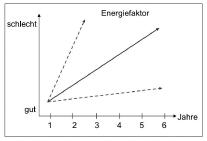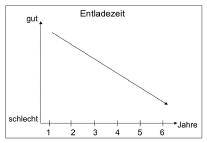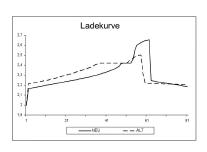Functions
|
|
Detecting performances
Since performance of lead acid batteries decrease at an increasing age and intensive utilization it is of great importance for the operation of vehicle fleets to recognise “weak” batteries in time and possibly replace them. Therefore with its long-term data the battery management system provides support

|
Energy factor over a number of years The ratio between the uploaded energy and the discharged energy (energy factor) shows an increasing tendency. |

|
Discharging time over a number of years: The time lapse until the discharging limit of a battery increasing for weakening batteries A long-term observation presents a definite tendency. |

|
Charging courses under similar charging conditions Batteries show a specific voltage behavior during charge which immediately supports the conclusion of the current performance. A comparison over a number of years reveals the current state of the battery. |
Causes for inefficiencies
The maximal and guaranteed performance of a lead acid battery up to the ZVEI standard is linked to certain conditions under application.
If the battery shows a preterm wear, the observing of the conditions has to be reviewed. For this the battery management system provides the following parameters:

|
Deep discharge Every deep discharge in the battery’s lifetime is recorded and immediately reported with the exact date. |

|
Excess temperature The overheat of a battery in the vehicle or at the chargers can be monitored simply and instantly. |

|
Failure of cells The failure of a cell not only conducts to an instant loss of power but also to an excess charge of the battery. All failure of cells is being reported and recorded immediately. |
Control over the whole battery lifetime
All relevant battery data of charging at the charger or discharging in the vehicels are available in terms of different analyses, e.g.:
|
During the charge at the charger -Full charges, partial charges -Charging time, idle time, total and separated into chargers -Charging end voltage -Uploaded capacitance, until/after charging end -temperature behavior -Chronology of the charging process |
During the discharge in the vehicle -Capacitance turnover -energy record -remainig capacitance at the battery change -Period of use in the vehicle (only combined with vehicular management) -Discharging streams -Available remaining number of cycles |
Simple battery administration
Administration of large stocks
The central so-called „Master Data Administrator” reunites a greater number of charging stations and batteries. On this PC all master data can be administrated centrally and distributed in every charging station. Accordingly batteries in all charging stations are recorded and can be utilized anywhere.



